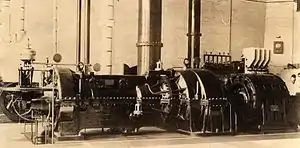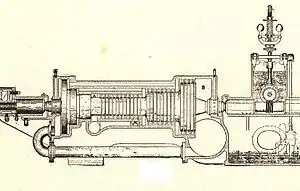Mary-Ann (turbine generator)
Mary-Ann was the nickname given to the first steam turbine used in a public utility to generate electricity in America. Hartford Electric Light Company of Hartford, Connecticut, realized an extra demand for electricity in 1900 and decided in 1901 to purchase this steam turbine generator. The turbine, built by Westinghouse and rated at 1.5 megawatts, ran at Hartford Electric's Pearl Street plant from 1901 to 1905.

History
Connecticut was prosperous at the beginning of the twentieth century. This attracted large populations of people. Many industries developed and needed electricity (whose original use was solely lighting) to run their machinery.
Hartford Electric Light Company of Hartford, Connecticut, realizing this extra demand for electricity decided in 1900 to install a massive three thousand horsepower machine to generate this huge amount of electricity that was needed.[1][2]
Description

Hartford Electric Light Company (HELCO) ordered in January 1901 a Westinghouse-Parsons type steam turbine built by the Westinghouse Electric and Manufacturing Company in East Pittsburgh, Pennsylvania. The steam turbine weighed over ninety-thousand pounds so a specifically designed railcar was built to transport it. The New York, New Haven and Hartford Railroad shipped the steam turbine.[1]
Their steam plant at Pearl Street housed the 45-ton Westinghouse unit that was about 7 feet high and about 7 feet in width.[3] The massive electric generating machine was nicknamed "Mary-Ann".[4] HELCO put the steam turbine into the powerplant in April 1901. It ran at 1,200 rpm, turning a generator that produced two-phase alternating current at 60 Hz and 2,400 V.[5]
The steam turbine electric generator performed as expected, but did have some difficulties at the beginning of installation. These problems were not entirely unexpected because there was no testing of the unit before shipment. Technology was not advanced enough and the manufacturer had no way of fully loading the machine for a thorough test before shipping. One of the troubles that developed when the turbine was in operation was with lubrication. The mechanism around the turbine shaft leaked some oil and came in contact with steam which impaired its lubricating ability.[5]
Another problem that came up because there was no testing at the manufacturer's shop was concerning thrust. The design of the huge turbine allowed for ease of dismantling, however this design flaw caused an unevenness of temperature under the superheated steam which made for poor performance. These flaws were redesigned and eventually corrected for satisfactory operation.[5] "Mary-Ann" produced 80,000 kilowatt-hours during the first year, 429,000 kilowatt-hours during the second year, 616,000 kilowatt-hours during the third year, and nearly 2,500,000 kilowatt-hours during the fourth year. The steam turbine electric generator was moved to their Dutch Point plant in 1905.[6]
Another problem was that the design of the steam turbine required the complete water supply of the Connecticut River that came into Hartford. To solve that problem three cooling towers were built to capture the steam of the turbine and condense it back to liquid water that could be used again. This way the same water could be used over and over again for about a year.[5]
Hartford Electric Light Company first ordered the steam turbine on January 1st and started installation on April 1. On October 5th it was in full operation to generate the electricity needed for the city of Hartford and surrounding area. It was the first company in America to use a steam turbine for a public utility to generate electricity.[4][7][8] "Mary-Ann" ran 84 hours during the first year, 555 hours during the second year, 721 hours during the third year, and 2,173 hours during the fourth year.[6]
The steam turbine electric generator was nominally rated at 1,500 kilowatts, but did have a maximum capacity of 1,900 kilowatts.[9] The boiler plant had three Aultman-Taylor water-tube boilers, each with a capacity of 550 hp. The condenser was of the barometer type and was manufactured by Worthington Company. The water for condensing purposes was supplied from three cooling towers that had 40 hp direct current motors for the fans.[10]
At the beginning the turbine was not in constant service, but usually repairs were required one or two days a week. Many times the blades of the turbine had to be replaced. This went on for two years before the problems were solved. This new technology ultimately replaced the old reciprocating steam engine and was the predecessor of all steam-station turbine electric generators in America today.[2]
Hartford Electric Light Company transmitted three-phase alternating current at high voltage in 1893 from an electrical generator similar to "Mary-Ann". It was from their Rainbow Hydroelectric Station in Windsor, Connecticut to its main station in Hartford – some eight miles away.[8]
References
- Mangan (2015), p. 22.
- Wilson (2014), p. 11.
- Hartford Steam 1924, p. 76.
- Mirecki, Zac. "Let There Be Light: An Early History of the Hartford Electric Light Company". Connecticut History.Org. Connecticut Humanities. Retrieved September 5, 2015.
The company had as its many assets Oil City, a second hydro plant at Tariffville (1899), and the steam plant at Pearl Street, which now housed the first steam turbine (a 45-ton Westinghouse unit named “Mary-Ann”) to be produced in America and installed in a public utility station.
- Iron (1902), p. 21.
- Hartford Steam (1924), p. 77.
- Kane (1997), p. 219.
- "Hartford Electric Light Company Records". Archives & Special Collections at the Thomas J. Dodd Research Center. University of Connecticut. 1996. Retrieved September 7, 2015.
The company was the first public utility in the United States to use steam turbines to drive its generators. The first turbine, nicknamed "Mary Ann" and weighing 91,700 pounds, was installed in the company's 266 Pearl Street generating station in Hartford in April 1901. It was a Westinghouse – Parsons type turbine manufactured by the Westinghouse Electric and Manufacturing Company in East Pittsburgh, Pennsylvania, with a turbo-generator capacity at 1500 kilowatts.
- Ferguson Publishing Company (1918), p. 130.
- Robb (1902), p. 11.
Sources
| Wikimedia Commons has media related to Mary-Ann (turbine generator). |
- Ferguson Publishing Company (1918). Steam. Ferguson Publishing Company.
The first steam turbine and electric generator unit in this country was a 1,500 kilowatt nominal rated machine, but having a maximum capacity of 1,900 kilowatts, which was installed by the 'Westinghouse Electric & Manufacturing Company' at the Hartford Electric Light Company, and started in April, 1901.
- Hartford Steam, Boiler Inspection and Insurance Company (July 1924). The Locomotive of the Hartford Steam Boiler Inspection and Insurance Company. Hartford, Connecticut.
- Iron (1902). Iron and Machinery World.
- Kane, Joseph Nathan (1997). Famous First Facts, Fifth Edition. The H. W. Wilson Company. ISBN 0-8242-0930-3.
The first steam turbine operated by a public utility to produce electricity was a 1,500-kilowatt steam turbine installed in April 1901 by the Hartford Electric Light Company, Hartford, CT, at its Pearl Street station. The turbine, manufactured by the Westinghouse Electric and Manufacturing Company, East Pittsburgh, PA, began to generate electricity in October 1901.
- Mangan, Gregg (2 March 2015). On This Day in Connecticut History. History Press. ISBN 978-1-62585-195-6.
- Robb, William (1902). The Electrical World and Engineer. McGraw Publishing Company. p. V40.
- Wilson, David Gordon (5 September 2014). The Design of High-Efficiency Turbomachinery and Gas Turbines. MIT Press. ISBN 978-0-262-32581-3.
